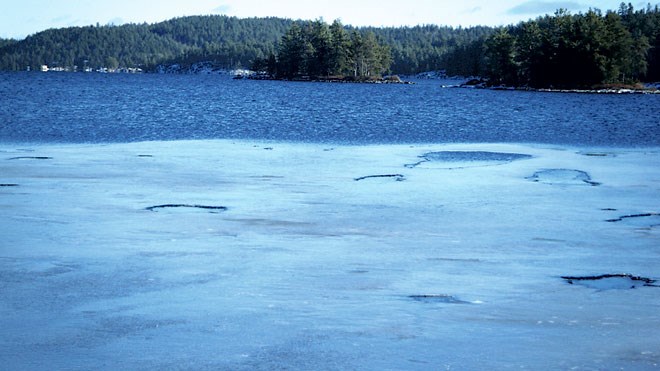I almost got out for one last paddle in the canoe on Nov. 28, but a 15-foot wide band of ice at the shoreline was too thick to get the boat into the water.
I wasn’t about to walk on it either. So, I tucked the canoe away and sat on shore. Watching and waiting.
Now, at long last, there is ice enough to go for a walk. We stepped from rocky shoreline onto the thick smooth ice.
Allan carried a long steel pole with an ice chipper on the end. I carried a long, lightweight birch pole.
The theory of the pole is that should you break through the ice, the pole can catch the edges of the hole and you can pull yourself out. I proved this to be true in my younger days — at least the first time I went in.
It did not work the second time. But that is another story.
I’ve learned a lot about lake ice over the decades and I had no intention of going on ice that had the remotest possibility of breaking.
Carrying the pole has become a comfortable habit for me. Even though I knew I would not need it, the pole gives a sense of security. Especially when the sun warms the surface just a bit and a loud crack sings through the ice under my feet.
Allan chipped holes in the ice here and there as we walked to the far shore. I kept an eye on the hairline cracks. Everywhere we walked, we found at least three inches of ice.
We walked the kilometre to the far shore. Then, we walked through the lowland swamp to cross the peninsula to the far side of the lake.
Water! Lots of water sparkled with sun reflecting off waves from the southwest wind. From the swamp, we climbed back onto land. Standing atop a small hill, we could see most of the lake still flowed free under the clear blue sky.
As long as the wind kept making waves, there would be no new ice. The movement of water under the ice would also thin the edges, with a good possibility that more ice would be gone by the end of the day.
We took another route on the way home. Walking on the ice on the west side of the peninsula, we were able to explore between islands and the grand expanse of solid ice from shore to shore.
I like to have a solid understanding of where the ice is good. This is best done at times like this, when there is no snow on it. It wasn’t necessary to go anywhere near the open water. We could see the waves from a good distance and the deeper blue of the wet.
Ice, wind, water, waves. Snow still lay thick in the bush. It’s all very beautiful.
Viki Mather has been commenting for Northern Life on the natural world and life in Greater Sudbury since the spring of 1984.
Join Sudbury.com+
- Messages
- Post a Listing
- Your Listings
- Your Profile
- Your Subscriptions
- Your Likes
- Your Business
- Support Local News
- Payment History
Sudbury.com+ members
Already a +member?
Not a +member?
Sign up for a Sudbury.com+ account for instant access to upcoming contests, local offers, auctions and so much more.
